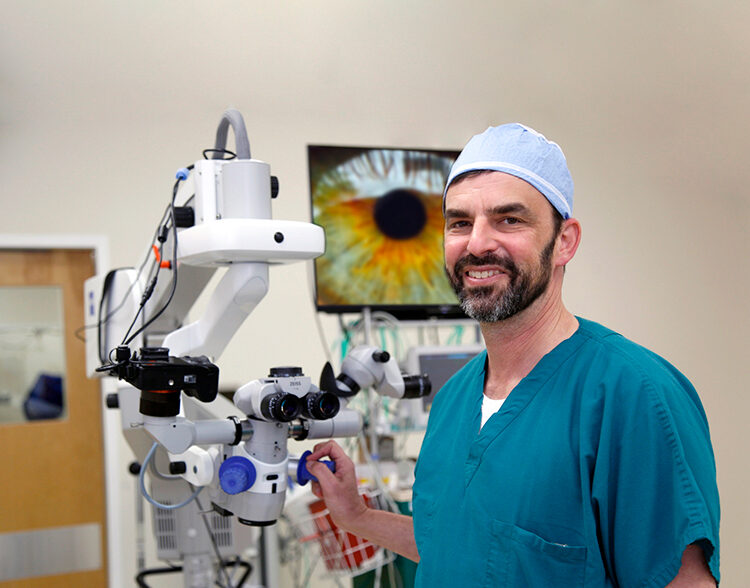
If you live long enough, the odds are you will need cataract surgery to remove a clouded lens and replace it with an artificial lens.
The natural lens is a clear structure behind the iris that focuses light into the retina. A clear lens means the retina receives a clear image and translates that clear image to the brain. When the lens becomes cloudy due to cataracts, vision is compromised and can be lost. Cataract removal is the only treatment option.
Fortunately, cataract surgery has the highest success rate of any surgical procedure in the United States. During the procedure, the clouded natural lens is replaced with a new, clear, carefully crafted piece of silicone or acrylic material called an intraocular lens implant.
And – more good news – an improved lens that can be adjusted for clearer vision after implantation recently became available.
“Up until about a year ago all intraocular lenses were set for distance [vision] or near [vision] or in between – just like a prescription for glasses – and then implanted into the eye,” said Dr. Marvin Gordon, ophthalmologist with New Vision Eye Center. “They were nonadjustable, monofocal lenses that couldn’t be changed after the procedure. Once you chose what you wanted for that eye, that was what you had forever.
“Within the last year, though, the FDA approved a new light adjustable lens that allows us to adjust the prescription of the lens after it’s already inside your eye. This new procedure gives our patients superior vision outcomes compared to traditional fixed or nonadjustable implants.
“The lens starts out at a certain power much like the standard monofocal, but it’s made of a photosensitive material that changes its shape when exposed to a specific wavelength and pattern of light,” he continued. “Just like other implants, measurements are taken before your cataract surgery to choose the prescription of the light adjustable lens that’s best for you. Unlike other lens implants, it can be adjusted after your surgery.
“Once your eye has healed from the cataract surgery, you will return to New Vison Eye Center and have your eyes tested. You will be able to preview the possible outcomes of the adjustments and choose what is right for you. Once that decision is made, we focus a UV spectrum light wave at different points of the lens to reshape it. When it becomes thicker, it has more power and the lens becomes rounder. A thinner lens provides less power. We can also correct astigmatisms in the process. If you are not satisfied with the results, we can readjust that same lens up to five times so that you can walk away with nearly perfect vision.”
Cataract surgery is done the same way when implanting the new light adjustable lenses as it is for standard fixed lenses. The only difference is the lens.
Some patients choose to stay awake during the procedure while others prefer conscious sedation. Either way, anesthetic drops are used to completely numb the nerves inside and around the eye to make the procedure painless. After the procedure, patients are instructed to go home and rest for the remainder of the day. Adjustments to the light adjustable lens are done in a regular exam room at the eye center with a special light-projecting device.
“Patients should wear UV protective glasses during all waking hours until the final adjustment is made,” Dr. Gordon continued. “Since the light adjustable lens material is sensitive to UV light, if you are exposed to UV light it could change its shape and change the prescription in an uncontrolled way. Once the adjustments are perfected, the patient will retain that vision for rest of his life.”
Light adjustable lens implants result in better vision after cataract surgery compared to fixed lens implants that can’t be adjusted, according to a study published by Best Cataract Surgeons in America. The study looked at approximately 600 patients who had cataract surgery with either the light adjustable lens or a traditional fixed lens and the results were conclusive. At six months postop 92 percent of patients who received the light adjustable lens were 20/25 or better compared to only 60.6 percent who received a fixed lens implant.
Nearly everyone is a good candidate for the light adjustable lens. Only a small minority of cataract surgery patients may be ineligible because of medications that increase sensitivity to light or if they have a history of ocular herpes simplex virus or nystagmus.
Light adjustable lenses are especially beneficial to patients for whom traditional lens implant measurements are less accurate. These include patients who have had previous LASIK, PRK or RK surgery, patients with high degrees of nearsightedness or farsightedness, or patients with irregular scarring or corneal ectasia.
“The biggest benefit of the light adjustable lens is that it takes away the margin of error in corneal refractive surgery,” Dr. Gordon concluded. “Having the ability to adjust the prescription after the surgery is a game-changer, for sure.”
Dr. Gordon joined New Vision Eye Center in January of 2023. He received his medical degree from The University of California, San Diego School of Medicine and interned at Tucson Hospitals Medical Education Program affiliated with the University of Arizona School of Medicine. His six years of post-graduate training included a fellowship in comprehensive ophthalmology at Jules Stein Eye Institute at UCLA and an ophthalmology residency at Brooklyn Jewish Hospital at Interfaith Medical Center in Brooklyn, N.Y. New Vision Eye Center is located at 1055 37th Place, Vero Beach. You can call 772-257-8700 to schedule an appointment.



